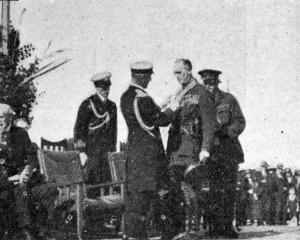It is said that lucerne growing marks the highest development in modern agriculture. The plant is the agricultural wonder of the twentieth century, and the most perfect animal food known to man.
It is very prolific, cheap to produce, highly nutritive and palatable, suiting equally sheep, cattle swine, poultry, horses, and even bees, much honey being obtained from the flowers, which are of all colours, but mainly blue or yellow.
The roots penetrate to an almost incredible depth, and in consequence of this lucerne is the salvation of dry and barren country and poor lands. The Government Agricultural Department has been experimenting with lucerne in Central Otago, and in view of what has been accomplished and the display now being made at part of the Government exhibit at the Winter Show, a representative of this paper had a long talk with Mr Macpherson, the Fields' Instructor for the South Island, regarding the plant.
Mr Macpherson stated that a dominion-wide recognition of the value of the forage, with the hearty co-operation of farmers, in establishing stands on even one-tenth of the area at present under cultivation would increase by 50 per cent. the volume of animal products available for export.
Mr Macpherson is convinced that it would be a great advantage to Otago if it were produced here, and Central Otago promises to be specially favourable for that purpose.
With the double advantage of the food value and seed value there should be a fortune in lucerne-growing in Central Otago to anyone who takes it up properly.
In proof of the fodder value, Mr J. Love, of Springvale, Galloway, last year, on an area of 25 acres, second years' growth, grazed 950 sheep from October 1 to the middle of December. He then took the stock off, cut a full growth, and then a half-growth, and has now eight stacks of lucerne.
He intends to send some 60 tons to Dunedin for sale, and yet this will leave him sufficient to increase the number of stock at present on his holding.
•At Saturday's meeting of the committee of the Gore Agricultural and Pastoral Association Mr T. Kain (Mandeville) stated that a large number of soldiers were returning and gravitating towards the towns.
If this continued it would mean a scarcity of labour on the farms still. That should be avoided as much as possible. The migration to the towns was noticeable in almost every walk of life.
In the high schools scarcely any of the pupils were taking the agricultural course. It was bad for the returned men to stay about the towns. They were likely to drift and not become as useful citizens as they might be.
It was in the interests of agriculture that men should be encouraged to remain on the land. He would like to see a remit on the matter sent to the conference. Mr G. P. Johnston supported Mr Kain's contention, and thought the idea should be crystallised in the form of a remit.
It was felt that farm labour would be scarce and something should be done to encourage settlement on the land. It was resolved, "That the secretary write to the Council of Agriculture on the subject and suggest that the conference should give the matter consideration.''
•A somewhat remarkable pair of tusks are in the possession of Mr Robert Winter, of Wyndham. They were obtained from an old "Captain Cook'' specimen shot by Mr Winter on Begg's Station, at the head of Wyndham Valley.
Each tusk forms a complete (overlapping) circle, and the points had necessarily become embedded in the animal's snout. The length of each tusk is 15¼in, and they are in flawless condition.
- ODT, 1.6.1916.
COPIES OF PICTURE AVAILABLE FROM ODT FRONT OFFICE, LOWER STUART ST, OR WWW.OTAGOIMAGES.CO.NZ












